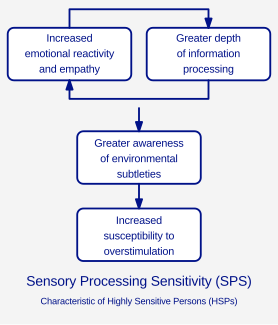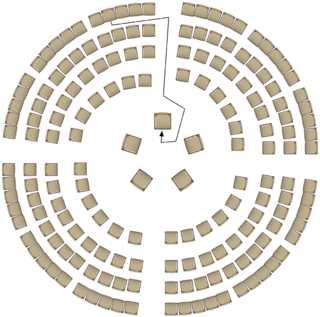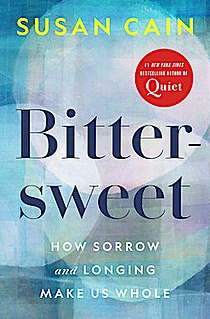
In personality typology, the Myers–Briggs Type Indicator (MBTI) is an introspective self-report questionnaire indicating differing psychological preferences in how people perceive the world and make decisions. The test attempts to assign a value to each of four categories: introversion or extraversion, sensing or intuition, thinking or feeling, and judging or perceiving. One letter from each category is taken to produce a four-letter test result, such as "INTJ" or "ESFP".

Shyness is the feeling of apprehension, lack of comfort, or awkwardness especially when a person is around other people. This commonly occurs in new situations or with unfamiliar people; a shy person may simply opt to avoid these situations. Although shyness can be a characteristic of people who have low self-esteem, the primary defining characteristic of shyness is a fear of what other people will think of a person's behavior. This fear of negative reactions such as being laughed at, humiliated or patronized, criticized or rejected can cause a shy person to retreat. Stronger forms of shyness can be referred to as social anxiety or social phobia.

Arousal is the physiological and psychological state of being awoken or of sense organs stimulated to a point of perception. It involves activation of the ascending reticular activating system (ARAS) in the brain, which mediates wakefulness, the autonomic nervous system, and the endocrine system, leading to increased heart rate and blood pressure and a condition of sensory alertness, desire, mobility, and readiness to respond.

Sensory processing sensitivity (SPS) is a temperamental or personality trait involving "an increased sensitivity of the central nervous system and a deeper cognitive processing of physical, social and emotional stimuli". The trait is characterized by "a tendency to 'pause to check' in novel situations, greater sensitivity to subtle stimuli, and the engagement of deeper cognitive processing strategies for employing coping actions, all of which is driven by heightened emotional reactivity, both positive and negative".
Cognitive functions, also referred to as psychological functions, as described by Carl Jung in his book Psychological Types, are particular mental processes within a person's psyche that are present regardless of common circumstance. This is a concept that serves as one of the foundations for his theory on personality type. In his book, he noted four main psychological functions: thinking, feeling, sensation, and intuition. He introduced them with having either an internally focused (introverted) or externally focused (extraverted) tendency which he called "attitudes". He also categorizes the functions as either rational or irrational.
In psychology, personality type refers to the psychological classification of different types of individuals. Personality types are sometimes distinguished from personality traits, with the latter embodying a smaller grouping of behavioral tendencies. Types are sometimes said to involve qualitative differences between people, whereas traits might be construed as quantitative differences. According to type theories, for example, introverts and extraverts are two fundamentally different categories of people. According to trait theories, introversion and extraversion are part of a continuous dimension, with many people in the middle. In contrast to personality traits, the existence of personality types remains extremely controversial.

A fishbowl conversation is a form of dialogue that can be used when discussing topics within large groups. Fishbowl conversations are sometimes also used in participatory events such as unconferences. The advantage of fishbowl is that it allows the entire group to participate in a conversation. Several people can join the discussion.

Elizabeth Wagele (1939–2017) was an American artist, musician, and writer of books on the Enneagram of Personality and the Myers-Briggs Type Indicator (MBTI).
Laurie Anne Helgoe is an American psychologist with a special interest in the relationship between personality development and culture. In 2008, her writing revealed that scholarly and popular accounts regarding humans who display the personality traits of introversion and extraversion were flawed, and that, instead of representing a 25-30% of the population, introverts make up 57% of the population. The identified flaw was a dated reliance on the early work of Isabel Briggs Myers, and the failure to note results of the latest nationally representative surveys using the Myers Briggs Type Indicator (MBTI), a questionnaire used by psychologists to classify human personality traits. Helgoe discussed these findings in the book Introvert Power: Why Your Inner Life is Your Hidden Strength.
Karl Moore is an associate professor at McGill University, Montreal, Quebec, Canada. He holds a joint appointment in the Department of Strategy and Organization at the Desautels Faculty of Management and the Department of Neurology and Neurosurgery at McGill's Faculty of Medicine, however, he is not a medical professional, he does leadership teaching and coaching. Moore was previously on the faculty of Templeton College at Oxford University for five years, where he remains an Associate Fellow. Before joining academia, he worked 12 years in sales and marketing management positions with IBM, Bull and Hitachi. Other schools he has taught at on MBA or executive programs include: Harvard Business School, Stanford, Duke, USC, Oxford, Cambridge, LBS, INSEAD, IMD, Skolkovo, Renmin, IIM Bangalore, NUS, and Keio University.
Asociality refers to the lack of motivation to engage in social interaction, or a preference for solitary activities. Asociality may be associated with avolition, but it can, moreover, be a manifestation of limited opportunities for social relations. Developmental psychologists use the synonyms nonsocial, unsocial, and social uninterest. Asociality is distinct from but not mutually exclusive to anti-social behaviour, in which the latter implies an active misanthropy or antagonism toward other people or the general social order. A degree of asociality is routinely observed in introverts, while extreme asociality is observed in people with a variety of clinical conditions.

The traits of extraversion and introversion are a central dimension in some human personality theories. The terms introversion and extraversion were introduced into psychology by Carl Jung, although both the popular understanding and current psychological usage vary. Extraversion tends to be manifested in outgoing, talkative, energetic behavior, whereas introversion is manifested in more reflective and reserved behavior. Jung defined introversion as an "attitude-type characterised by orientation in life through subjective psychic contents", and extraversion as "an attitude-type characterised by concentration of interest on the external object".

Susan Horowitz Cain is an American writer and lecturer.

Quiet: The Power of Introverts in a World That Can't Stop Talking is a 2012 nonfiction book written by American author and lecturer Susan Cain. Cain argues that modern Western culture misunderstands and undervalues the traits and capabilities of introverted people, leading to "a colossal waste of talent, energy, and happiness".

Quiet Revolution LLC is a privately owned, mission-based, for-profit, American company formed with a stated mission “to unlock the power of introverts for the benefit of us all.” The company has initiatives for business, government, office space planning, education, lifestyle and parenting. Quiet Revolution was formally launched in 2015 based on principles in Susan Cain’s 2012 book Quiet: The Power of Introverts in a World That Can't Stop Talking.
Temperament Isolation Theory, also known as personality bias or personality discrimination, is a recent social science theory that attempts to explain how cultures favor a specific temperament and how they view and interact with those of other or opposite temperaments. The first concepts of the theory were explored by Susan Cain in her book Quiet where she looked at how western cultures, particularly the United States, value extroversion over introversion and how that could possibly make it difficult for introverts to thrive in society. Northern Arizona University professor Jorge Rodriguez III took the idea a step further and viewed how the opposite could be viewed in eastern cultures where introversion is valued over extroversion. These observations and further research led to the concept of "personality bias" which suggests certain personalities are favored over others and that these opposing personalities are "intentionally or unintentionally oppressed or muted." The concept of personality bias was later formally formulated into Temperament Isolation Theory. The theory is currently not widely accepted among social scientists, but it is gaining ground thanks to the research of Rodriguez and others.
Paul Mones is an American lawyer and author. Mones specializes in representing victims of child sexual abuse against institutions like the Boy Scouts of America and the Catholic Church. He has also defended children accused of killing a parent. He is the author of the books When a Child Kills: Abused Children Who Kill Their Parents and Stalking Justice: The Dramatic True Story of the Detective Who First Used DNA Testing to Catch a Serial Killer.
Hamja Ahsan is an radical left wing artist, writer, curator and activist. A multi-disciplinary artist, his practice has involved conceptual writing, building archives, performance, video, sound and making zines. Reoccurring themes have been explorations around state crime, contemporary Islamophobia, repression of civil liberties under the War on Terror, and prison solidarity.

Bittersweet: How Sorrow and Longing Make Us Whole is a 2022 book written by American author Susan Cain.











